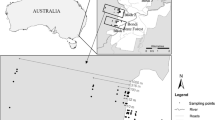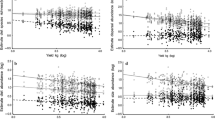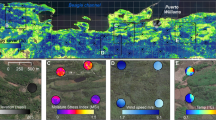Abstract
Land-use change due to agriculture has a major influence on arthropod biodiversity, and may influence species differently depending on their traits. It is unclear how species traits vary across different land uses and their edges, with most studies focussing on single habitat types and overlooking edge effects. We examined variation in morphological traits of carabid beetles (Coleoptera:Carabidae) on both sides of edges between woodlands and four adjoining, but contrasting farmland uses in an agricultural landscape. We asked: (1) how do traits differ between woodlands and different adjoining farmland uses (crop, fallow, restoration planting, and woody debris applied over crop), and do effects depend on increasing distances from the farmland–woodland edge? (2) Does vegetation structure explain observed effects of adjoining farmland use and edge effects on these traits? We found that carabid communities varied in body size and shape, including traits associated with diet, robustness, and visual ability. Smaller sized species were associated with woodlands and larger sized species with farmlands. Farmland use further influenced these associations, where woodlands adjoining plantings supported smaller species, while fallows and crops supported larger species. Vegetation structure significantly influenced body size, flying ability, and body shape, and helped explain the effects of farmland use and distance from edges on body size. We highlight the important role of vegetation structure, farmland use, and edge effects in filtering the morphological traits of carabid assemblages across a highly modified agricultural landscape. Our findings suggest that farmland management can influence body size and dispersal-related traits in farmland and adjacent native vegetation.


Similar content being viewed by others
References
Allen CR, Garmestani AS, Havlicek TD, Marquet PA, Peterson GD, Restrepo C, Stow CA, Weeks BE (2006) Patterns in body mass distributions: sifting among alternative hypotheses. Ecol Lett 9:630–643
Barnes AD, Emberson RM, Krell F-T, Didham RK (2014) The role of species traits in mediating functional recovery during matrix restoration. PLoS ONE 9:e115385
Barton PS, Gibb H, Manning AD, Lindenmayer DB, Cunningham SA (2011) Morphological traits as predictors of diet and microhabitat use in a diverse beetle assemblage. Biol J Linn Soc 102:301–310
Battin J (2004) When good animals love bad habitats: ecological traps and the conservation of animal populations. Conserv Biol 18:1482–1491
Blake S, Foster G, Eyre M, Luff M (1994) Effects of habitat type and grassland management practices on the body size distribution of carabid beetles. Pedobiologia 38:502–512
Brose U (2003) Bottom-up control of carabid beetle communities in early successional wetlands: mediated by vegetation structure or plant diversity? Oecologia 135:407–413
Brouwers NC, Newton AC (2009) Movement rates of woodland invertebrates: a systematic review of empirical evidence. Insect Conserv Diver 2:10–22
Brown AM, Warton DI, Andrew NR, Binns M, Cassis G, Gibb H (2014) The fourth-corner solution – using predictive models to understand how species traits interact with the environment. Methods Ecol Evol 5:344–352
Cardoso P, Erwin TL, Borges PAV, New TR (2011) The seven impediments in invertebrate conservation and how to overcome them. Biol Conserv 144:2647–2655
Carrié R, Andrieu E, Cunningham SA, Lentini PE, Loreau M, Ouin A (2017) Relationships among ecological traits of wild bee communities along gradients of habitat amount and fragmentation. Ecography 40:85–97
Chown SL, Gaston KJ (2010) Body size variation in insects: a macroecological perspective. Biol Rev 85:139–169
Davies KF, Margules CR, Lawrence JF (2000) Which traits of species predict population declines in experimental forest fragments? Ecology 81:1450–1461
Driscoll DA, Weir T (2005) Beetle responses to habitat fragmentation depend on ecological traits, habitat condition, and remnant size. Conserv Biol 19:182–194
Driscoll DA, Banks SC, Barton PS, Lindenmayer DB, Smith AL (2013) Conceptual domain of the matrix in fragmented landscapes. Trends Ecol Evol 28:605–613
Duflot R, Georges R, Ernoult A, Aviron S, Burel F (2014) Landscape heterogeneity as an ecological filter of species traits. Acta Oecologica 56:19–26
Evans MJ, Banks SC, Davies KF, Mcclenahan J, Melbourne B, Driscoll DA (2016) The use of traits to interpret responses to large scale—edge effects: a study of epigaeic beetle assemblages across a Eucalyptus forest and pine plantation edge. Landscape Ecol 31:1–17
Eyre MD, Luff ML, Leifert C (2013) Crop, field boundary, productivity and disturbance influences on ground beetles (Coleoptera, Carabidae) in the agroecosystem. Agricult Ecosyst Environ 165:60–67
Eyre MD, McMillan SD, Critchley CNR (2016) Ground beetles (Coleoptera, Carabidae) as indicators of change and pattern in the agroecosystem: longer surveys improve understanding. Ecol Indic 68:82–88
Fischer J, Lindenmayer DB, Montague-Drake R (2008) The role of landscape texture in conservation biogeography: a case study on birds in south-eastern Australia. Divers Distrib 14:38–46
Forsythe TG (1987) The relationship between body form and habit in some Carabidae (Coleoptera). J Zool 211:643–666
Fountain-Jones NM, Baker SC, Jordan GJ (2015) Moving beyond the guild concept: developing a practical functional trait framework for terrestrial beetles. Ecol Entomol 40:1–13
Gerisch M (2011) Habitat disturbance and hydrological parameters determine the body size and reproduction strategy of alluvial ground beetles. ZooKeys 100:353–370
Gibb H, Parr CL (2010) How does habitat complexity affect ant foraging success? A test using functional measures on three continents. Oecologia 164:1061–1073
Gibb H, Parr CL (2013) Does structural complexity determine the morphology of assemblages? An experimental test on three continents. PLoS ONE 8:e64005
Gibb H, Stoklosa J, Warton DI, Brown AM, Andrew NR, Cunningham SA (2015) Does morphology predict trophic position and habitat use of ant species and assemblages? Oecologia 177:519–531
Gibb H, Retter B, Cunningham SA, Barton PS (2017) Does wing morphology affect recolonization of restored farmland by ground-dwelling beetles? Restor Ecol 25:234–242
Hanson HI, Palmu E, Birkhofer K, Smith HG, Hedlund K (2016) Agricultural land use determines the trait composition of ground beetle communities. PLoS ONE 11:e0146329
Holling CS (1992) Cross-scale morphology, geometry, and dynamics of ecosystems. Ecol Monogr 62:447–502
Kaspari M (1993) Body size and microclimate use in Neotropical granivorous ants. Oecologia 96:500–507
Kaspari M, Weiser MD (1999) The size-grain hypothesis and interspecific scaling in ants. Funct Ecol 13:530–538
Kotze DJ, O’Hara RB (2003) Species decline—but why? Explanations of carabid beetle (Coleoptera, Carabidae) declines in Europe. Oecologia 135:138–148
Laparie M, Lebouvier M, Lalouette L, Renault D (2010) Variation of morphometric traits in populations of an invasive carabid predator (Merizodus soledadinus) within a sub-Antarctic island. Biol Invasions 12:3405–3417
Lawrence JF, Britton EB (1994) Australian beetles. Melbourne University Press, Carlton
Lawrence J, Hastings A, Dallwitz M, Paine T, Zurcher E (2000). Beetles of the world. a key and information system for families and subfamilies, version 1.0. CSIRO Entomology, Canberra
Legendre P, Galzin R, Harmelin-Vivien ML (1997) Relating behaviour to habitat: solutions to the fourth-corner problem. Ecology 78:547–562
Lockhart R, Taylor J, Tibshirani RJ, Tibshirani R (2014) A significance test for the LASSO. Ann Stat 42:413–468
Lovei GL, Sunderland KD (1996) Ecology and behavior of ground beetles (Coleoptera: Carabidae). Annu Rev Entomol 41:231–256
Magura T (2017) Ignoring functional and phylogenetic features masks the edge influence on ground beetle diversity across forest-grassland gradient. Forest Ecol Manag 384:371–377
Magura T, Lövei GL, Tóthmérész B (2017) Edge responses are different in edges under natural versus anthropogenic influence: a meta-analysis using ground beetles. Ecol Evolut 7:1009–1017
McGill BJ, Enquist BJ, Weiher E, Westoby M (2006) Rebuilding community ecology from functional traits. Trends Ecol Evol 21:178–185
Moretti M, Dias ATC, de Bello F, Altermatt F, Chown SL, Azcárate FM, Bell JR, Fournier B, Hedde M, Hortal J, Ibanez S, Öckinger E, Sousa JP, Ellers J, Berg MP (2017) Handbook of protocols for standardized measurement of terrestrial invertebrate functional traits. Funct Ecol 31:558–567
Munro NT, Lindenmayer DB, Fischer J (2007) Faunal response to revegetation in agricultural areas of Australia: a review. Ecol Manag Restor 8:199–207
Norris E, Thomas J (1991) Vegetation on rocky outcrops and ranges in central and south-western New South Wales. Cunninghamia 2:411–441
Öckinger E, Schweiger O, Crist TO, Debinski DM, Krauss J, Kuussaari M, Petersen JD, Pöyry J, Settele J, Summerville KS, Bommarco R (2010) Life-history traits predict species responses to habitat area and isolation: a cross-continental synthesis. Ecol Lett 13:969–979
Oliver I, Beattie AJ (1996) Invertebrate morphospecies as surrogates for species: a case study. Conserv Biol 10:99–109
Parr ZJE, Parr CL, Chown SL (2003) The size-grain hypothesis: a phylogenetic and field test. Ecol Entomol 28:475–481
Rand TA, Tylianakis JM, Tscharntke T (2006) Spillover edge effects: the dispersal of agriculturally subsidized insect natural enemies into adjacent natural habitats. Ecol Lett 9:603–614
Rasband WS (2007). ImageJ, U.S. National Institutes of Health, Bethesda, Maryland, from http://rsb.info.nih.gov/ij/. Accessed May 2017
Ribera I, McCracken DI, Foster GN, Downie IS, Abernethy VJ (1999) Morphological diversity of ground beetles (Coleoptera: Carabidae) in Scottish agricultural land. J Zool 247:1–18
Ribera I, Dolédec S, Downie IS, Foster GN (2001) Effect of land disturbance and stress on species traits of ground beetle assemblages. Ecology 82:1112–1129
Ries L, Fletcher RJ Jr, Battin J, Sisk TD (2004) Ecological responses to habitat edges: mechanisms, models, and variability explained. Annu Rev Ecol Evol S 35:491–522
Rouabah A, Villerd J, Amiaud B, Plantureux S, Lasserre-Joulin F (2015) Response of carabid beetles diversity and size distribution to the vegetation structure within differently managed field margins. Agricult Ecosyst Environ 200:21–32
Rusch A, Birkhofer K, Bommarco R, Smith HG, Ekbom B (2015) Predator body sizes and habitat preferences predict predation rates in an agroecosystem. Basic Appl Ecol 16:250–259
Seibold S, Brandl R, Buse J, Hothorn T, Schmidl J, Thorn S, Müller J (2015) Association of extinction risk of saproxylic beetles with ecological degradation of forests in Europe. Conserv Biol 29:382–390
Shibuya S, Kikvidze Z, Toki W, Kanazawa Y, Suizu T, Yajima T, Fujimori T, Mansournia MR, Sule Z, Kubota K, Fukuda K (2014) Ground beetle community in suburban Satoyama—a case study on wing type and body size under small scale management. J Asia-Pac Entomol 17:775–780
Siemann E, Haarstad J, Tilman D (1999) Dynamics of plant and arthropod diversity during old field succession. Ecography 22:406–414
Talarico F, Brandmayr P, Giglio A, Massolo A, Brandmayr TZ (2011) Morphometry of eyes, antennae and wings in three species of Siagona (Coleoptera, Carabidae). ZooKeys 203–214
Teuscher M, Brändle M, Traxel V, Brandl R (2009) Allometry between leg and body length of insects: lack of support for the size–grain hypothesis. Ecol Entomol 34:718–724
Thiele H-U (1977) Carabid beetles in their environments. A study on habitat selection by adaptation in physiology and behaviour. Springer-Verlag, Berlin
Tibshirani R (1996) Regression shrinkage and selection via the lasso. J R Stat Soc B Met 267–288
Tscharntke T, Klein AM, Kruess A, Steffan-Dewenter I, Thies C (2005) Landscape perspectives on agricultural intensification and biodiversity—ecosystem service management. Ecol Lett 8:857–874
Tscharntke T, Tylianakis JM, Rand TA, Didham RK, Fahrig L, Batáry P, Bengtsson J, Clough Y, Crist TO, Dormann CF, Ewers RM, Fründ J, Holt RD, Holzschuh A, Klein AM, Kleijn D, Kremen C, Landis DA, Laurance W, Lindenmayer D, Scherber C, Sodhi N, Steffan-Dewenter I, Thies C, van der Putten WH, Westphal C (2012) Landscape moderation of biodiversity patterns and processes - eight hypotheses. Biol Rev 87:661–685
Wang Y, Naumann U, Wright S, Eddelbuettel D, Warton D (2016) Mvabund: Statistical methods for analysing multivariate abundance data. R package version 3.11.9, from http://CRAN.R-project.org/package=mvabund. Accessed May 2017
Warton DI, Foster SD, De’ath G, Stoklosa J, Dunstan PK (2015). Model-based thinking for community ecology. Plant Ecol 216:669–682
Weiser MD, Kaspari M (2006) Ecological morphospace of New World ants. Ecol Entomol 31:131–142
Wiescher PT, Pearce-Duvet JM, Feener DH (2012) Assembling an ant community: species functional traits reflect environmental filtering. Oecologia 169:1063–1074
Winqvist C, Bengtsson J, Öckinger E, Aavik T, Berendse F, Clement LW, Fischer C, Flohre A, Geiger F, Liira J, Thies C, Tscharntke T, Weisser WW, Bommarco R (2014) Species’ traits influence ground beetle responses to farm and landscape level agricultural intensification in Europe. J Insect Conserv 18:837–846
Wood SA, Karp DS, DeClerck F, Kremen C, Naeem S, Palm CA (2015) Functional traits in agriculture: agrobiodiversity and ecosystem services. Trends Ecol Evol 30:531–539
Yates ML, Andrew NR, Binns M, Gibb H (2014) Morphological traits: predictable responses to macrohabitats across a 300 km scale. PeerJ 2:e271
Acknowledgements
This work was supported by Central Tablelands Local Land Services (through Australian Government funding), Lake Cowal Foundation and Mount Mulga Pastoral Company. KN was supported by an Australian Government Research Training Program (RTP) scholarship. Thanks to landholders (Day, Foy, Conlan, Hall, Lucas, Nowlan, Aylott, Grimm, Robinson, Crawford, Daley families) for property access. We thank volunteers for fieldwork (particularly Alicia Ng, Nicholas Shore, Margaret Ning, Mal Carnegie and Dimitrios Tsifakis) and lab assistance (particularly Daniel Martinez-Escobar); Kim Pullen, and Michael Nash for carabid identification.
Author information
Authors and Affiliations
Contributions
KN and DAD conceived the ideas and design for overall experiment, KN, PB, and SaM conceived and developed traits methodology, KN analysed data with statistical input from WB and MJE, KN and MJE conducted lab work, KN conducted fieldwork and led manuscript writing, and all authors revised the manuscript.
Corresponding author
Ethics declarations
Conflict of interest
The authors declare that they have no conflict of interest.
Ethical approval
This article does not contain any studies with human participants or animals performed by any of the authors.
Additional information
Communicated by Nina Farwig.
This study deserves to be honoured as a highlighted student paper because it uncovers the ecological mechanisms underpinning fauna responses to land-use change. Our study is the first to quantify how changes in farmland use and vegetation structure both influence a universally important trait, body size, across the landscape. The novelty of our study lies in the use of traits-based approaches in a robust landscape-level experimental design. In contrast to the perception that farmlands are biodiversity poor, our findings highlight that a diversity of species were represented by a range of traits which enable their persistence in these dynamic farming landscapes.
Electronic supplementary material
Below is the link to the electronic supplementary material.
Rights and permissions
About this article
Cite this article
Ng, K., Barton, P.S., Blanchard, W. et al. Disentangling the effects of farmland use, habitat edges, and vegetation structure on ground beetle morphological traits. Oecologia 188, 645–657 (2018). https://doi.org/10.1007/s00442-018-4180-9
Received:
Accepted:
Published:
Issue Date:
DOI: https://doi.org/10.1007/s00442-018-4180-9




